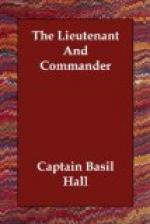The state in which the ship happens to be at the time she is commissioned, must decide, as I said before, the course to be followed in her equipment. If she be already masted and alongside the hulk, and the ballast in, the officer will most likely wish to make some show in the way of rigging—for as yet the masts are naked to the girt-lines, or single ropes rove through blocks at the mast-head, by which first the men and then the shrouds are drawn up, and the eyes of the rigging placed over the mast-heads. If there be only a few sailors on board, these can be employed to get off the furniture, that is, all the blocks, ready stropped in the rigging loft; and to draw the present use stores from the dockyard. These can all be kept under lock and key in the store-rooms of the hulk; and if the rigging, and everything required in placing it aloft, be previously fitted and arranged by the boatswain, so that he can put his hand at once on the gear as soon as a sufficient number of the crew join, much time will be saved. Even the lower rigging may be got off all ready fitted from the loft; while the runners and tackles, the luffs, and other purchases, may be put in preparation for use the moment there are hands enough to employ on them.
By application to the boatswain of the yard, assistance will be given to gammon the bowsprit, preparatory to its being clothed, which is the technical term for rigging that important spar. One of its principal offices is to support the foremast and fore-topmast, by means of their stays, as the slanting ropes are called which stretch forwards and downwards from the head of every mast, great and small, in the ship. Some of these, as the main-stay, lie at so inconsiderable an angle with the horizon, that they possess great power of sustaining the mast; while others, such as the fore-stay, being necessarily more perpendicular, do not act to such good mechanical purpose. There is a peculiar disadvantage attending the method of securing the fore-stay, arising from the position of the mast. It is placed so near the extremity of the ship, that the stay, which forms its only support in the forward direction, cannot be attached to the body of the vessel, without making so very small an angle with the mast as would divest it of nearly all its character as a supporter. To remedy this, the bowsprit has been devised, chiefly as an out-rigger for the fore-stay. But in order to render the spar effective for that purpose, it requires to be very strongly bound down. There has, therefore, been contrived what is called the stem, or cut-water, which is a strong but narrow projection from the bows, securely fastened by long and thick bolts of iron and copper to the body of the ship. The chief purpose of this stem is to furnish a point of support for the ropes securing the bowsprit. Of these, the most important is called the gammoning, which consists of a strong and well-stretched hawser, passed up and down successively, in perpendicular turns,




